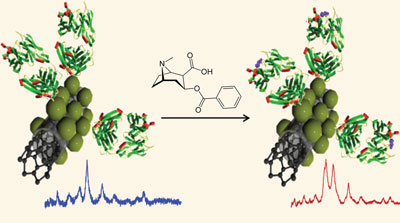| Posted: August 18, 2009 |
Nanotechnology sensor detects drug abuse |
|
(Nanowerk News) Spanish scientists have made antibody-coated nanoparticles that can detect bioanalytes indicative of drug abuse (Label-free SERS detection of relevant bioanalytes on silver-coated carbon nanotubes: The case of cocaine).
|
 |
| When the metabolite binds to the antibodies it causes a change in the SERS spectrum
|
|
Ramón Alvarez-Puebla and colleagues at the University of Vigo attached antibodies specific to a major cocaine metabolite, benzoylecgonine, to the surface of carbon nanotube-supported silver nanoparticles. They then added a solution of benzoylecgonine, which bound to the antibodies and caused a change in their structure. The team showed that surface-enhanced Raman spectroscopy (SERS) could be used to monitor the structural changes and determine the metabolite concentration.
|
|
The method can be performed in biological fluids, such as saliva or urine, says Alvarez-Puebla, and can determine not only the drug's presence but also the amount consumed. It could also be used to detect disease-related biomolecules, he suggests.
|
|
Current SERS analytical techniques usually require preparatory steps, such as the incorporation of labels that give a signal when molecules of interest are present. '[This method] is interesting because you do not need to prepare the sample at all,' Alvarez-Puebla comments. The method's sensitivity matches that of established techniques, he adds.
|
|
Douglas Stuart from the University of West Georgia, Carrollton, US, who specialises in SERS and nanotechnology, is impressed by the work. 'It is a very elegant approach that takes an unintended consequence [the structural change of the antibody] and uses it as a detection method - a slick trick!'
|
|
The group are now working on developing new sensors, including those capable of monitoring more than one analyte, for use in high-throughput screening.
|

